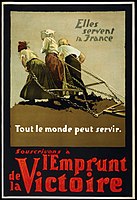Wikipedia:Featured picture candidates/Canadian war bond posters, World War I
Appearance
- War bond posters, 1918
-
Canadian victory bond poster in French. Depicts three French women pulling a plow. Lithograph, adapted from a photograph.
-
The same poster in English, with subtle differences in text. The French version roughly translates as 'All the world can serve' and 'Let's buy victory bonds.'
- Reason
- Nominating this pair of posters as a set. High resolution Canadian war bond lithographs in French and English that depict three French women pulling a plow that had been built for horses and men. Restored versions of File:Canada WWI l'Emprunt de la Victoire.jpg and File:Canada WWI Victory Bonds.jpg.
- Articles this image appears in
- Canadian_identity#20th_century, Military_history_of_Canada_during_the_First_World_War
- Creator
- Unknown lithographer, based upon a photograph by Brown Bros.
- Support as nominator --DurovaCharge! 20:07, 12 February 2009 (UTC)
- Support the notion of having to send the same message in multiple languages ... great example. GerardM (talk) 21:30, 12 February 2009 (UTC)
- Comment: doesn't the French version translate differently? I'm reasonably sure, even with the differences in Canadian French, that "Tout le monde peu servir" doesn't mean "How can I server Canada?" - surely 'tout le monde' is 'the whole world'. "Elles servent la France" is a direct translation though. —Vanderdecken∴ ∫ξφ 22:10, 12 February 2009 (UTC)
- Yes, the French version is slightly different. 'All the world can serve' or 'Everyone can serve'. Less specific about who is being served. DurovaCharge! 22:49, 12 February 2009 (UTC)
- In return, the caption at the bottom is first person: "Let's buy victory bonds" (or literally, "let's subscribe to the borrowing of victory"). Stevage 00:10, 13 February 2009 (UTC)
- Pas une autre peinture de français! Not another French painting! (err, lithograph) I can confirm Stevage's translation, and while it sounds stuffy literally, it it idiomatic in French.--HereToHelp (talk to me) 00:47, 13 February 2009 (UTC)
- As long as this difference is noted in the captions (so we don't get more people asking the question I did), Support. —Vanderdecken∴ ∫ξφ 09:31, 13 February 2009 (UTC)
- Which one came first?--HereToHelp (talk to me) 21:28, 13 February 2009 (UTC)
- The bibliographic information doesn't state which was designed first. DurovaCharge! 21:38, 13 February 2009 (UTC)
- Which one came first?--HereToHelp (talk to me) 21:28, 13 February 2009 (UTC)
- As long as this difference is noted in the captions (so we don't get more people asking the question I did), Support. —Vanderdecken∴ ∫ξφ 09:31, 13 February 2009 (UTC)
- Pas une autre peinture de français! Not another French painting! (err, lithograph) I can confirm Stevage's translation, and while it sounds stuffy literally, it it idiomatic in French.--HereToHelp (talk to me) 00:47, 13 February 2009 (UTC)
- In return, the caption at the bottom is first person: "Let's buy victory bonds" (or literally, "let's subscribe to the borrowing of victory"). Stevage 00:10, 13 February 2009 (UTC)
- Yes, the French version is slightly different. 'All the world can serve' or 'Everyone can serve'. Less specific about who is being served. DurovaCharge! 22:49, 12 February 2009 (UTC)
- Support - great visual appeal, historic, vibrant. Cheers, Abraham, B.S. (talk) 07:31, 13 February 2009 (UTC)
- Support - The yokes on them!
- *facepalm* —Vanderdecken∴ ∫ξφ 09:31, 13 February 2009 (UTC)
Promoted File:Canada WWI l'Emprunt de la Victoire2.jpg
Promoted File:Canada WWI Victory Bonds2.jpg MER-C 02:47, 21 February 2009 (UTC)


